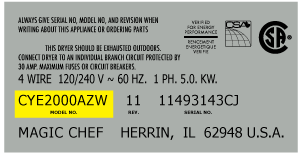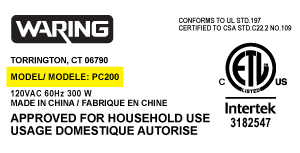91149489992 Kenmore Microwave Oven Combo - Instructions
Keep searches simple. Use keywords, e.g. "leaking", "pump", "broken" or "fit".
Microwave completely stopped working
Turned out the issue was easily solved by replacing a single, inexpensive fuse.
First off, UNPLUG THE MICROWAVE.
The fuse is located under the plastic grill at the top of the microwave. It's held on by two screws. Once you've removed the screws and taken off the plastic grill, you go to the right side of the microwave and remove another screw that holds a small metal grill in place. Removing the small metal grill is probably the toughest part of this repair. You kind of have to rock it back and forth a bit to get it to release. Once that's off, you can get to the fuse. I removed the burnt out one with a pair of needle nose pliers. I also put a small piece of cardboard under the fuse when I did this so I didn't accidentally drop it into the innards of the microwave. I did the same thing when I replaced the new fuse. I then plugged the appliance back in and made sure it worked. Once that was confirmed, I replaced both grills.
First off, UNPLUG THE MICROWAVE.
The fuse is located under the plastic grill at the top of the microwave. It's held on by two screws. Once you've removed the screws and taken off the plastic grill, you go to the right side of the microwave and remove another screw that holds a small metal grill in place. Removing the small metal grill is probably the toughest part of this repair. You kind of have to rock it back and forth a bit to get it to release. Once that's off, you can get to the fuse. I removed the burnt out one with a pair of needle nose pliers. I also put a small piece of cardboard under the fuse when I did this so I didn't accidentally drop it into the innards of the microwave. I did the same thing when I replaced the new fuse. I then plugged the appliance back in and made sure it worked. Once that was confirmed, I replaced both grills.
Parts Used:
-
Kim from Cliffside Park, NJ
-
Difficulty Level:Really Easy
-
Total Repair Time:15 - 30 mins
-
Tools:Screw drivers
962 of 1249 people
found this instruction helpful.
Was this instruction helpful to you?
Thank you for voting!
Oven tempature was approximately 150 degrees to low
This repair is EASY if you know how to use an ohm meter. If not, seek help for this step.
SYMPTOM:
The oven (JKP27WOP3WG or JKP27WP3WG and many ovens like it ) was not getting hot enough. Verifying the cooking temperature with an typical oven thermometer, I was able to determine that the oven was cooking temperature was about 150 degrees to low.
FAILURE POINTS:
There are two logical failure points (1) The oven sensor ( WB21X5301 about $75), or the (2) the controller board (PS238233 about $252). In my case it was the controller board. When replaced the oven worked beautifully.
REPAIR:
As with any repair, you MUST DISCONNECT POWER TO THE UNIT BEFORE SERVICING!!!
Pull oven from the wall:
- Disconnect power by flipping the circuit breaker to the OFF position.
- Remove the top flange / cowling from the top of the oven (it just pulls off)
- Remove two screws under the top flange / cowling
- The whole unit easily slides out, but it is highly recommended that you use two people to place the oven on the floor.
As a diagnostic between these two parts, if the oven sensors measure approximately 1.1K ohms of resistance at room temperature, then it is probably not the sensor. The oven sensor wires are connected to two white wires that run up to the controller board. You need to disconnect the oven sensor to make the measurement. You may either completely remove the oven sensor by cutting the wire (be sure to allow yourself enough slack so that they may be safely reconnected) where it connects to the white wires, OR, (preferred method) if leaving the oven sensor partially installed,
- Remove the top sheet metal cover (10 screws)
- Remove the service connect cover (2 screws - this is where the main Power cord comes into the unit)
- Disconnect the white wires from the controller board (this connector which also includes other circuits is on the left side when looking at the controller board).
- Remove two screws from oven sensor but just let in dangle down so that you can put the sensor in the ice water / boiling water.
Measure the resistance under the following conditions. Your ohm meter should read APPROXIMATELY...
- 1.02K ohms in ice water
- 1.09K ohms at room temperature
- 1.36K ohms in boiling water.
If you get approximately these readings, then it is NOT the oven sensor. If that checks out then re-install the sensor AND the connector.
If it is NOT the sensor, replace the controller board.
- Take a moment to write down the color of the wire to the LETTERING (N, L, G, C / COM,,,) on the controller board. The connectors are in different locations on the new controller board so the wire color to the letter designation is significant.
- Carefully remove the wires one at a time
- VERY carefully remove the keypad ribbon cable from the right side of the controller board.
-- The ribbon cable will disconnect by releasing some little pressure clips on the side of the connector.
- Remove the controller board (4 screws)
- Install new controller board (4 screws)
- VERY carefully connect the keypad ribbon cable on the right side.
-- Make sure that the connector is in the OPEN position first, then,
-- Slide in the cable ensuring that all parts of the ribbon made it into the connector, then
-- Press down on the connector locking tabs.
- Reconnect each wire to the correctly lettering on the board.
-- Again, the connectors MAY BE in a different order on the replacement controller board. Match color to letter.
- Reconnect the (5 wire?) connector that includes the white oven sensor wires.
- Make sure everything looks normal, (i.e. no wires are pinched, remove tools from top of oven area, etc.)
- Re-install top cover.
- Re-install service connect cover.
You can test the unit while it is out of the cabinet,
- Make SURE that all sheet metal covers are in place.
- Flip power breaker to "On".
- Test that oven gets to the desired temp.
SYMPTOM:
The oven (JKP27WOP3WG or JKP27WP3WG and many ovens like it ) was not getting hot enough. Verifying the cooking temperature with an typical oven thermometer, I was able to determine that the oven was cooking temperature was about 150 degrees to low.
FAILURE POINTS:
There are two logical failure points (1) The oven sensor ( WB21X5301 about $75), or the (2) the controller board (PS238233 about $252). In my case it was the controller board. When replaced the oven worked beautifully.
REPAIR:
As with any repair, you MUST DISCONNECT POWER TO THE UNIT BEFORE SERVICING!!!
Pull oven from the wall:
- Disconnect power by flipping the circuit breaker to the OFF position.
- Remove the top flange / cowling from the top of the oven (it just pulls off)
- Remove two screws under the top flange / cowling
- The whole unit easily slides out, but it is highly recommended that you use two people to place the oven on the floor.
As a diagnostic between these two parts, if the oven sensors measure approximately 1.1K ohms of resistance at room temperature, then it is probably not the sensor. The oven sensor wires are connected to two white wires that run up to the controller board. You need to disconnect the oven sensor to make the measurement. You may either completely remove the oven sensor by cutting the wire (be sure to allow yourself enough slack so that they may be safely reconnected) where it connects to the white wires, OR, (preferred method) if leaving the oven sensor partially installed,
- Remove the top sheet metal cover (10 screws)
- Remove the service connect cover (2 screws - this is where the main Power cord comes into the unit)
- Disconnect the white wires from the controller board (this connector which also includes other circuits is on the left side when looking at the controller board).
- Remove two screws from oven sensor but just let in dangle down so that you can put the sensor in the ice water / boiling water.
Measure the resistance under the following conditions. Your ohm meter should read APPROXIMATELY...
- 1.02K ohms in ice water
- 1.09K ohms at room temperature
- 1.36K ohms in boiling water.
If you get approximately these readings, then it is NOT the oven sensor. If that checks out then re-install the sensor AND the connector.
If it is NOT the sensor, replace the controller board.
- Take a moment to write down the color of the wire to the LETTERING (N, L, G, C / COM,,,) on the controller board. The connectors are in different locations on the new controller board so the wire color to the letter designation is significant.
- Carefully remove the wires one at a time
- VERY carefully remove the keypad ribbon cable from the right side of the controller board.
-- The ribbon cable will disconnect by releasing some little pressure clips on the side of the connector.
- Remove the controller board (4 screws)
- Install new controller board (4 screws)
- VERY carefully connect the keypad ribbon cable on the right side.
-- Make sure that the connector is in the OPEN position first, then,
-- Slide in the cable ensuring that all parts of the ribbon made it into the connector, then
-- Press down on the connector locking tabs.
- Reconnect each wire to the correctly lettering on the board.
-- Again, the connectors MAY BE in a different order on the replacement controller board. Match color to letter.
- Reconnect the (5 wire?) connector that includes the white oven sensor wires.
- Make sure everything looks normal, (i.e. no wires are pinched, remove tools from top of oven area, etc.)
- Re-install top cover.
- Re-install service connect cover.
You can test the unit while it is out of the cabinet,
- Make SURE that all sheet metal covers are in place.
- Flip power breaker to "On".
- Test that oven gets to the desired temp.
Parts Used:
-
James from Austin, TX
-
Difficulty Level:Easy
-
Total Repair Time:1- 2 hours
-
Tools:Nutdriver, Screw drivers
222 of 261 people
found this instruction helpful.
Was this instruction helpful to you?
Thank you for voting!
The broiler element caught fire and burned out while I was broiling a steak.
First I removed the two screws that hold the element in place. I then pulled the element out about 3 inches, but I had not turned off the power.
So, I shorted out one of the wires. Then I turned off the power but was afraid to go any farther.
An appliance repairman was at my house that day fixing my dryer seal. He was able to pull the wires through the insulation successfully and install the broiler element. He did not charge me any extra for this little extra job. But I learned my lesson. Cut the power before you begin! He told me that I could have wound up with a much bigger repair if the short had been in the wire that is connected to the control panel of the oven. I was very lucky!
So, I shorted out one of the wires. Then I turned off the power but was afraid to go any farther.
An appliance repairman was at my house that day fixing my dryer seal. He was able to pull the wires through the insulation successfully and install the broiler element. He did not charge me any extra for this little extra job. But I learned my lesson. Cut the power before you begin! He told me that I could have wound up with a much bigger repair if the short had been in the wire that is connected to the control panel of the oven. I was very lucky!
Parts Used:
-
Dianne from Rockville, MD
-
Difficulty Level:Easy
-
Total Repair Time:Less than 15 mins
-
Tools:Nutdriver
67 of 75 people
found this instruction helpful.
Was this instruction helpful to you?
Thank you for voting!
Top broiler element went out
FIRST MAKE SURE THE OVEN IS OFF!!!! I chose to shut it off at the breaker panel. Remove the two screws that attaches the broiler element to the oven. Gently pull it out. Unplug the two cable wires that are attached. Replace it and install the same way.
Parts Used:
-
Kim from Garland, TX
-
Difficulty Level:Really Easy
-
Total Repair Time:15 - 30 mins
-
Tools:Nutdriver
39 of 43 people
found this instruction helpful.
Was this instruction helpful to you?
Thank you for voting!
Oven would not heat to the correct temperature
First I removed the two screws that hold the element in place. I then pulled the element out about 3 inches and disconnected the two wires
Parts Used:
-
Michael from Lawrenceville, GA
-
Difficulty Level:Really Easy
-
Total Repair Time:Less than 15 mins
-
Tools:Screw drivers
40 of 63 people
found this instruction helpful.
Was this instruction helpful to you?
Thank you for voting!
I diagnosed the problem incorrectly: based on a previous repair.
-
Ralph from Brandon, FL
-
Difficulty Level:Easy
-
Total Repair Time:Less than 15 mins
-
Tools:Pliers, Screw drivers
64 of 137 people
found this instruction helpful.
Was this instruction helpful to you?
Thank you for voting!
Microwave no longer functional. Power and fuse check good.
1. Opened door to remove glass dish and plastic rotating wheel.
2. Turned breaker "off" to appliance at main electrical panel.
3. Removed two "star" screws located on side of front control panel.
4. Removed four screws (two top and bottom) from front bezel around the wall mount microwave unit.
5. With bezel removed; removed four screws (two top and bottom) from the frame seecuring the microwave above the conventional oven directly below.
6. Using an inverted laundry basket; slide the microwave unit out approx. 14-16 inches and balance the extended weight on the inverted laundry basket. I opened the oven door and placed the laundry basket on it.....was a good fit!
7. With the side sheet metal now exposed; remove four hex nut screws (black) from unit.
8. Also, swing front control panel open; notice two sheetmetal tabs securing side panel. bend each up to help release side panel.
9. NOTE: The sheet metal enclosure is a shield for the microwave unit. It interlocks around the side cover preventing accidental removal.
10. By removing the four hex screws, you will notice two philips screws toward the rear of the unit. Remove both of these screws and the side panel should come out exposing the magnatron.
11. Uplug the magnatron and light. The light is in a white plastic cover and the magnetron is the main device in the unit. There was a schematic in my unit that helps illustrate each of the locations.
12. NOTE: There are capacitors toward the lower rear of the unit that will remain charged although power is off. Safely dscharge these capacitors or don't service this unit on your own.
13. Remove the magnatron by removing the four philips screws attaching it to the side enclosure.
14. Remove the plastic cover encasing the light by removing three philips screws.
15. NOTE: The replacement magnetron does not include the thermal sensor secured to its case. You must remove this from the old unit or buy a new one. There are two small philips screws securing this in place.
16. Reverse order to install new units.
17. NOTE: there is a gasket on the magnetron (around the hole where the rotating head projects into the cooking chamber. Ensure gasket is properly installed to prevent microwave leakage.
18. Once everything is reinstalled; place glass of water in unit to test. Set controls properly and turn on. Water should be hot per setting.
2. Turned breaker "off" to appliance at main electrical panel.
3. Removed two "star" screws located on side of front control panel.
4. Removed four screws (two top and bottom) from front bezel around the wall mount microwave unit.
5. With bezel removed; removed four screws (two top and bottom) from the frame seecuring the microwave above the conventional oven directly below.
6. Using an inverted laundry basket; slide the microwave unit out approx. 14-16 inches and balance the extended weight on the inverted laundry basket. I opened the oven door and placed the laundry basket on it.....was a good fit!
7. With the side sheet metal now exposed; remove four hex nut screws (black) from unit.
8. Also, swing front control panel open; notice two sheetmetal tabs securing side panel. bend each up to help release side panel.
9. NOTE: The sheet metal enclosure is a shield for the microwave unit. It interlocks around the side cover preventing accidental removal.
10. By removing the four hex screws, you will notice two philips screws toward the rear of the unit. Remove both of these screws and the side panel should come out exposing the magnatron.
11. Uplug the magnatron and light. The light is in a white plastic cover and the magnetron is the main device in the unit. There was a schematic in my unit that helps illustrate each of the locations.
12. NOTE: There are capacitors toward the lower rear of the unit that will remain charged although power is off. Safely dscharge these capacitors or don't service this unit on your own.
13. Remove the magnatron by removing the four philips screws attaching it to the side enclosure.
14. Remove the plastic cover encasing the light by removing three philips screws.
15. NOTE: The replacement magnetron does not include the thermal sensor secured to its case. You must remove this from the old unit or buy a new one. There are two small philips screws securing this in place.
16. Reverse order to install new units.
17. NOTE: there is a gasket on the magnetron (around the hole where the rotating head projects into the cooking chamber. Ensure gasket is properly installed to prevent microwave leakage.
18. Once everything is reinstalled; place glass of water in unit to test. Set controls properly and turn on. Water should be hot per setting.
Parts Used:
-
Tim from Gilbert, AZ
-
Difficulty Level:Easy
-
Total Repair Time:30 - 60 mins
-
Tools:Screw drivers, Wrench (Adjustable), Wrench set
30 of 37 people
found this instruction helpful.
Was this instruction helpful to you?
Thank you for voting!
Noise and no Heat on Microwave oven.
First, I waste $65 by calling some "REPAIR" service. They showed at home and charge me that just to tell me
Second, I researched on the web and ordered a part, which was not the issue. I waste abnother $72
Third, I found Part-Select and got the right answer: the Diode was the problem. Ordered the part form Part-Select and it FIxed it !!!
Note: I did not buy a new microwave because this one is mounted on the wall and it will cost me +$800 just the lowest price.
Second, I researched on the web and ordered a part, which was not the issue. I waste abnother $72
Third, I found Part-Select and got the right answer: the Diode was the problem. Ordered the part form Part-Select and it FIxed it !!!
Note: I did not buy a new microwave because this one is mounted on the wall and it will cost me +$800 just the lowest price.
Parts Used:
-
Luis from Plano, TX
-
Difficulty Level:Easy
-
Total Repair Time:Less than 15 mins
-
Tools:Screw drivers, Wrench set
33 of 49 people
found this instruction helpful.
Was this instruction helpful to you?
Thank you for voting!
appliance stopped working -- no readout on screen
1. turned off electricity -- unplugged the unit 2. removed 3 screws on top of top vent, removed vent screen then I located the little white cylindrical fuse and popped it out with a table knife. Then I popped in the new fuse. Replaced the vent screen and screws -- plugged in the appliance and it is working again.
Parts Used:
-
Carolyn from ARMONK, NY
-
Difficulty Level:Easy
-
Total Repair Time:30 - 60 mins
-
Tools:Screw drivers
24 of 24 people
found this instruction helpful.
Was this instruction helpful to you?
Thank you for voting!
F2 error message on my GE oven indicated need for new heat sensor
After unscrewing the old heat sensor from inside the oven, I pulled the range away from the wall, got behind it and removed the small panel over the heat sensor. Naturally, the plastic clips connecting the heat sensor to the range wiring wouldn't come apart, so I eventually had to simply pry them apart with two pliers. Then, naturally, the new plastic connector clip on the replacement part didn't match the clip from the range, so I had to cut off both receptacles and strip the wires, then used the provided wire nuts to make the connections. After that, it was easy, just secured the heat sensor inside the oven and replaced the panel. I didn't push the range back against the wall until I tested the repair. It worked fine!
Parts Used:
-
Joseph from Brick, NJ
-
Difficulty Level:A Bit Difficult
-
Total Repair Time:30 - 60 mins
-
Tools:Nutdriver, Pliers
25 of 29 people
found this instruction helpful.
Was this instruction helpful to you?
Thank you for voting!
would blow the internal 15amp fuse when pressing the start button
Used the trouble shooting guide and wire diagram found inside the microwave (thanks GE). Found the HV capacitor and diode had shorted. Replaced the capacitor and diode........works like new.
Parts Used:
-
Eugene from Standish, ME
-
Difficulty Level:Easy
-
Total Repair Time:15 - 30 mins
-
Tools:Screw drivers
20 of 27 people
found this instruction helpful.
Was this instruction helpful to you?
Thank you for voting!
Suddenly had no heat. All else worked fine. A deep odd hum sound.
This did not fix my problem. I've ordered a new microwave.
First off, UNPLUG THE MICROWAVE.
The fuse is located under the plastic grill at the top of the microwave. It's held on by two screws. Once you've removed the screws and taken off the plastic grill, you go to the right side of the microwave and remove another screw that holds a small metal grill in place. Removing the small metal grill is probably the toughest part of this repair. You kind of have to rock it back and forth a bit to get it to release. Once that's off, you can get to the fuse. I removed the burnt out one with a pair of needle nose pliers. I also put a small piece of cardboard under the fuse when I did this so I didn't accidentally drop it into the innards of the microwave. I did the same thing when I replaced the new fuse. I then plugged the appliance back in and made sure it worked. Once that was confirmed, I replaced both grills.
First off, UNPLUG THE MICROWAVE.
The fuse is located under the plastic grill at the top of the microwave. It's held on by two screws. Once you've removed the screws and taken off the plastic grill, you go to the right side of the microwave and remove another screw that holds a small metal grill in place. Removing the small metal grill is probably the toughest part of this repair. You kind of have to rock it back and forth a bit to get it to release. Once that's off, you can get to the fuse. I removed the burnt out one with a pair of needle nose pliers. I also put a small piece of cardboard under the fuse when I did this so I didn't accidentally drop it into the innards of the microwave. I did the same thing when I replaced the new fuse. I then plugged the appliance back in and made sure it worked. Once that was confirmed, I replaced both grills.
Parts Used:
-
Katherine from WILLIAMSTOWN, NJ
-
Difficulty Level:Very Easy
-
Total Repair Time:15 - 30 mins
-
Tools:Pliers, Screw drivers
17 of 18 people
found this instruction helpful.
Was this instruction helpful to you?
Thank you for voting!
Replacement of heating element
If I'd had the Nut driver, it would have taken 15 -20 minutes or less. Went to Ace Hardware, bought the nut driver for $4.99.
Turn off the power at the box! Turn off the oven as well. Four screws total. Two to hold it in place and two that connect the element to the source.
First I removed the two screws that hold the element in place. I pulled the element out about 2 inches. Two more screws connect the element wires. I disconnected the element, threw it away, then connected the new element. I put the element in place, then replaced the screws that connect the power. Finally, I replaced the screws that hold the element in place.
Kimberly, El Cerrito, California
Turn off the power at the box! Turn off the oven as well. Four screws total. Two to hold it in place and two that connect the element to the source.
First I removed the two screws that hold the element in place. I pulled the element out about 2 inches. Two more screws connect the element wires. I disconnected the element, threw it away, then connected the new element. I put the element in place, then replaced the screws that connect the power. Finally, I replaced the screws that hold the element in place.
Kimberly, El Cerrito, California
Parts Used:
-
Kimberly from El Cerrito, CA
-
Difficulty Level:Really Easy
-
Total Repair Time:15 - 30 mins
-
Tools:Nutdriver, Screw drivers
16 of 16 people
found this instruction helpful.
Was this instruction helpful to you?
Thank you for voting!
Oven stops heating and states F3 error code.
The most obbious suspect is the upper oven fan. Turned off power circuit breaker. Removed two philip screws at top of control panel and lowered the panel. Using the 3D view of the oven on this web site I located the fan limit switch. Jumpered the limit switch. Turned power on and the fan ran. That proved the switch was defective and not the fan. Replaced the limit I purchased from Partselect.com.
Please note* My life career was electrical. I used the schematic that came with the oven to determine that the limit was the only control between one of the 240 volt lines and the fan. Thus I knew it was safe to jump the limit.
If you are in doubt, seek some advice.
Good Luck, Arno
Please note* My life career was electrical. I used the schematic that came with the oven to determine that the limit was the only control between one of the 240 volt lines and the fan. Thus I knew it was safe to jump the limit.
If you are in doubt, seek some advice.
Good Luck, Arno
Parts Used:
-
Arno from Sacramento, CA
-
Difficulty Level:Easy
-
Total Repair Time:30 - 60 mins
-
Tools:Nutdriver, Screw drivers
19 of 26 people
found this instruction helpful.
Was this instruction helpful to you?
Thank you for voting!
oven shut down code F3
As has been said shut down unit,Breaker fuse.If you do not have install info.Get a copy on line. If you have another set of hands it would not hurt.! this has been stated before. Remove door, Remove 4 screws , to slide unit out,I used a saw horse with some cribing secured to the horse to get height, Pull the oven out so that the two front supports are on the saw horse,and the back two are up to the edge runner.I used about a 1 ft stool for working height. Remove the top elec. cover sheet metal 2 screws. You will see were the wireing runs down the back. Get a small mirror,and flash light. Look down the wire opening in the back, you see the sensor connection ,I made a hook out of a coat hanger to grab it with. Pull it up before you disconnect it ,tie a piece of string to the sensor side of the connector , use 2 Ft. then disconnect remove two screws from inside the oven. And remove,sensor tie string on to new sensor connector pull through and connect.on top.Then replace everything cck every thing Twice!Doing this i didn"t have to pull the unit all the way out! LATER GOOD LUCK!
Parts Used:
-
Richard from Jupiter, FL
-
Difficulty Level:A Bit Difficult
-
Total Repair Time:1- 2 hours
-
Tools:Nutdriver, Screw drivers
17 of 24 people
found this instruction helpful.
Was this instruction helpful to you?
Thank you for voting!
































